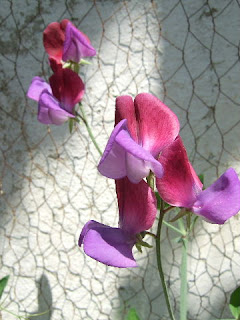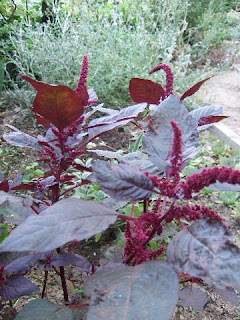In Seattle, June and early July were the real peak times in my garden. Here it's earlier, and now that things are getting good and hot; the ephemerals are done, and I'm mostly keeping busy just trying to keep up with watering.
In the flower garden, the Lavatera I call "ex-Barnsley" is going great guns, and is considerably taller than I am. I say "ex" Barnsley because I bought Lavatera "Barnsley" years ago in my Seattle garden and for two or three years it produced the pale pink, dark-centered flowers. But sometimes this variety reverts back to it's original form, a much more uniform pink. I got my start early in the spring and didn't know it had reverted until later, but no matter, I still like it even if I probably would never have actually bought it. The pink flowers keep coming for a weeks and weeks, standing out against the small dark green leaves. It's quite drought-tolerant to boot.

 The sweet peas are on their last legs now. This is the first year I've ever been really successful with them and it was worth the extra effort. I grew two old varieties: Cupani, a bicolor pink that was among the first to be grown in Europe, and Matucana, reputed to be the closest to the original species. Both are known for their exceptional fragrance. They certainly lived up to the hype; I brought a few flowers of "Matucana" (L), and they soon overwhelmed me on the table where I was working, so they went across the room! Now there is one forlorn pink flower left, and lots of seed pods. The stink bug can't be getting much of a meal from the almost-dry pods, so he must just be here for the exposure.
The sweet peas are on their last legs now. This is the first year I've ever been really successful with them and it was worth the extra effort. I grew two old varieties: Cupani, a bicolor pink that was among the first to be grown in Europe, and Matucana, reputed to be the closest to the original species. Both are known for their exceptional fragrance. They certainly lived up to the hype; I brought a few flowers of "Matucana" (L), and they soon overwhelmed me on the table where I was working, so they went across the room! Now there is one forlorn pink flower left, and lots of seed pods. The stink bug can't be getting much of a meal from the almost-dry pods, so he must just be here for the exposure.
The big old magnolia tree is in full bloom, and though it's a bit scruffy and the old yellowing blooms still hang on, but a newly-opened magnolia is a beautiful thing to behold.

Down below, an enormous old canna is in full bloom. I used to hate cannas. With their banana-like foliage, they just seemed not to fit anywhere in Iowa where I grew up. The real problem was what they were planted with, or not planted with. Ours is a variety of the "indian shot" canna, named for its rock-hard seeds. It's not as flamboyantly showy as some of the hybrids are, I like it. They are incredibly easy to propagate from seed, you need to scarify them (I use a steak knife to get past the hard black seed coat) and soak them in water overnight. Once they sprout they develop very quickly. I started a few this spring, and out of eight, one came up with red leaves so it was a keeper.

The other thing in full bloom is the sunflowers. They have an interesting personality, there's somethign old-fashioned about them, and they always make me think of a bunch of old pioneer women standing around gossiping. I don't remember what the variety was, but it's a mixture of various colors with branching stems. There were supposed to be pinks and whites in there but mine all range through yellows to reddish browns. The other thing they don't do is face the sun; they look any way they feel like. I didn't plant a single one on purpose; they are all volunteers from the ones I grew last year.

Just like last year, I had a crowd of five-foot ones, and a single very tall one (as in about 8 feet) with a very dark center and smaller petals in relation to its large center. It has a slightly different habit than the others as well; while the shorter ones tend to set new buds close together, this one makes more of a "boquet" of flowers each on its individual long stem.

It's really a little late for Nigella but for some reason mine got off to a late start. So they are blooming all over the place and I'm humoring them with water, but the tallest one is a foot or so tall. Next year they'll volunteer on their own time.

The Daturas are some of my favorite night-bloomers. Not sure which one this is, either metel or wrightii. The plant is perennial here, coming back from the roots each spring. The enormous white flowers open just before dusk, and when several open at once, the fragrance fills the entire garden.

Last on today's list is Amaranth "Hopi Red Dye," which I've been growing for several years now. I abuse it, otherwise it would a lot larger. When it's happy, it can get up to five feet tall, but when they grow in the flower garden with mostly drought-tolerant plants, they rarely get over two feet tall, and grow in nice mid-sized clumps. Like most amaranths the leaves are edible, though I prefer the local wild green one for eating, and will talk about them in the next post.



2 comments:
please don't talk to me about hot, its disgusting here. Lovely magnolia and nigella. Do you eat the nigella seeds? I sometimes use it to decorate bread, like I would sesame seeds.
Are your neighbors talking to you again after that massive arum bloom?
:) The Amorphophallus is history! No major incidents thankfully. Nigella - this is N. damascena, not the one that they use on breads (N. sativa). The seeds of N. damascena are bigger but also have a fragrance - just like Juicy Fruit gum! There are some really strange other Nigella species around as well.
Post a Comment